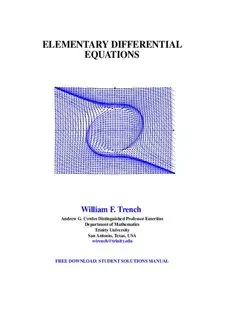
ELEMENTARY DIFFERENTIAL EQUATIONS PDF
Preview ELEMENTARY DIFFERENTIAL EQUATIONS
ELEMENTARY DIFFERENTIAL EQUATIONS William F. Trench Andrew G.CowlesDistinguishedProfessor Emeritus DepartmentofMathematics TrinityUniversity SanAntonio,Texas, USA [email protected] This bookhas been judgedtomeet the evaluationcriteriaset by theEd- itorial Board of the American Institute of Mathematics in connection with the Institute’s OpenTextbookInitiative. It may be copied, modi- fied,redistributed,translated,transported,andbuiltuponsubjecttothe CreativeCommons Attribution-NonCommercial-ShareAlike3.0 UnportedLicense FREE DOWNLOAD:STUDENTSOLUTIONSMANUAL FreeEdition1.01(December2013) ThisbookwaspublishedpreviouslybyBrooks/ColeThomsonLearning,2001.Thisfreeeditionismade available in the hope that it will be useful as a textbook or reference. Reproduction is permitted for any validnoncommercial educational, mathematical, orscientific purpose. However, charges for profit beyondreasonableprintingcostsareprohibited. TO BEVERLY Contents Chapter1 Introduction 1 1.1ApplicationsLeadingtoDifferentialEquations 1.2 FirstOrderEquations 5 1.3 DirectionFieldsforFirstOrderEquations 16 Chapter2 FirstOrderEquations 30 2.1 LinearFirstOrder Equations 30 2.2 SeparableEquations 45 2.3 ExistenceandUniquenessofSolutionsofNonlinearEquations 55 2.4 TransformationofNonlinearEquationsintoSeparableEquations 63 2.5 ExactEquations 73 2.6 IntegratingFactors 83 Chapter3 NumericalMethods 3.1 Euler’sMethod 96 3.2 TheImprovedEulerMethodandRelatedMethods 109 3.3 TheRunge-KuttaMethod 119 Chapter4 ApplicationsofFirstOrderEquations1em 130 4.1 GrowthandDecay 130 4.2 CoolingandMixing 140 4.3 ElementaryMechanics 151 4.4 AutonomousSecondOrderEquations 162 4.5 ApplicationstoCurves 179 Chapter5 LinearSecondOrderEquations 5.1 HomogeneousLinearEquations 194 5.2 ConstantCoefficientHomogeneousEquations 210 5.3 NonhomgeneousLinearEquations 221 5.4 TheMethodofUndeterminedCoefficientsI 229 iv 5.5 TheMethodofUndeterminedCoefficientsII 238 5.6 ReductionofOrder 248 5.7 VariationofParameters 255 Chapter6 ApplcationsofLinearSecondOrderEquations 268 6.1 SpringProblemsI 268 6.2 SpringProblemsII 279 6.3 TheRLC Circuit 291 6.4 MotionUnderaCentralForce 297 Chapter7 SeriesSolutionsofLinearSecondOrderEquations 7.1 ReviewofPowerSeries 307 7.2 SeriesSolutionsNearanOrdinaryPointI 320 7.3 SeriesSolutionsNearanOrdinaryPointII 335 7.4 RegularSingularPointsEulerEquations 343 7.5 TheMethodofFrobeniusI 348 7.6 TheMethodofFrobeniusII 365 7.7 TheMethodofFrobeniusIII 379 Chapter8 LaplaceTransforms 8.1 IntroductiontotheLaplaceTransform 394 8.2 TheInverseLaplaceTransform 406 8.3 SolutionofInitialValueProblems 414 8.4 TheUnitStepFunction 421 8.5 ConstantCoefficientEquationswithPiecewiseContinuousForcing Functions 431 8.6 Convolution 441 8.7 ConstantCofficientEquationswithImpulses 453 8.8 ABriefTableofLaplaceTransforms Chapter9 LinearHigherOrderEquations 9.1 IntroductiontoLinearHigherOrderEquations 466 9.2 HigherOrderConstantCoefficientHomogeneousEquations 476 9.3 UndeterminedCoefficientsforHigherOrderEquations 488 9.4 VariationofParametersforHigherOrderEquations 498 Chapter10 LinearSystemsofDifferentialEquations 10.1 IntroductiontoSystemsofDifferentialEquations 508 10.2 LinearSystemsofDifferentialEquations 516 10.3 BasicTheoryofHomogeneousLinearSystems 522 10.4 ConstantCoefficientHomogeneousSystemsI 530 vi Contents 10.5 ConstantCoefficientHomogeneousSystemsII 543 10.6 ConstantCoefficientHomogeneousSystemsII 557 10.7 VariationofParametersforNonhomogeneousLinearSystems 570 Preface ElementaryDifferentialEquationswithBoundaryValueProblemsiswrittenforstudentsinscience, en- gineering,andmathematicswhohavecompletedcalculusthroughpartialdifferentiation.Ifyoursyllabus includesChapter10(LinearSystemsofDifferentialEquations),yourstudentsshouldhave some prepa- rationinlinearalgebra. InwritingthisbookIhavebeenguidedbythetheseprinciples: An elementary text shouldbe writtenso the student can read itwithcomprehension withouttoo (cid:15) muchpain. Ihave triedtoputmyselfinthestudent’splace, andhave chosentoerronthesideof toomuchdetailratherthannotenough. Anelementarytextcan’tbebetterthanitsexercises. Thistextincludes1695numberedexercises, (cid:15) manywithseveralparts. Theyrangeindifficultyfromroutinetoverychallenging. Anelementary textshouldbe writteninan informalbutmathematically accurate way, illustrated (cid:15) by appropriate graphics. I have triedto formulate mathematical concepts succinctly in language thatstudentscan understand. Ihave minimizedthenumberofexplicitlystatedtheoremsanddef- initions, preferring to deal with concepts in a more conversational way, copiously illustratedby 250completelyworkedoutexamples. Whereappropriate,conceptsandresultsaredepictedin144 figures. AlthoughI believe that the computer is an immensely valuable toolforlearning, doing, and writing mathematics, theselectionandtreatmentoftopicsinthistextreflects mypedagogicalorientationalong traditionallines. However, Ihave incorporatedwhatIbelieve tobe thebestuse ofmoderntechnology, soyoucan selecttheleveloftechnologythatyouwanttoincludeinyourcourse. Thetextincludes336 exercises–identifiedbythesymbols C and C/G –thatcallforgraphicsorcomputationandgraphics. There are also73laboratoryexercises –identifiedby L –thatrequireextensive useoftechnology. In addition,severalsectionsincludeinformaladviceontheuseoftechnology.Ifyouprefernottoemphasize technology,simplyignoretheseexercises andtheadvice. Therearetwoschoolsofthoughtonwhethertechniquesandapplicationsshouldbetreatedtogetheror separately. Ihave chosentoseparate them;thus,Chapter2dealswithtechniquesforsolvingfirstorder equations,andChapter4dealswithapplications. Similarly,Chapter5dealswithtechniquesforsolving secondorderequations,andChapter6dealswithapplications.However,theexercisesetsofthesections dealingwithtechniquesincludesomeappliedproblems. Traditionallyorientedelementarydifferentialequationstextsare occasionallycriticizedas beingcol- lectionsofunrelatedmethodsforsolvingmiscellaneousproblems. Tosomeextentthisistrue;afterall, nosinglemethodappliestoallsituations.Nevertheless,Ibelievethatoneideacangoalongwaytoward unifyingsomeofthetechniquesforsolvingdiverseproblems:variationofparameters. Iusevariationof parametersattheearliestopportunityinSection2.1,tosolvethenonhomogeneouslinearequation,given anontrivialsolutionofthecomplementaryequation.Youmayfindthisannoying,sincemostofuslearned thatoneshoulduseintegratingfactorsforthistask,whileperhapsmentioningthevariationofparameters optioninanexercise. However,there’slittledifferencebetweenthetwoapproaches,sinceanintegrating factor isnothingmore thanthe reciprocal of a nontrivialsolutionof the complementary equation. The advantageofusingvariationofparameters hereisthatitintroducestheconceptinitssimplestformand vii viii Preface focusesthestudent’sattentionontheideaofseekingasolutiony ofadifferentialequationbywritingit asy uy ,wherey isaknownsolutionofrelatedequationanduisafunctiontobedetermined. Iuse 1 1 D thisideainnonstandardways,asfollows: In Section2.4 tosolve nonlinearfirst orderequations, such as Bernoulliequationsand nonlinear (cid:15) homogeneousequations. InChapter3fornumericalsolutionofsemilinearfirstorderequations. (cid:15) InSection5.2toavoidthenecessityofintroducingcomplex exponentialsinsolvinga secondor- (cid:15) derconstantcoefficienthomogeneousequationwithcharacteristicpolynomialsthathavecomplex zeros. In Sections 5.4, 5.5, and 9.3 for the method of undetermined coefficients. (If the method of an- (cid:15) nihilatorsis your preferred approach to thisproblem, compare the laborinvolved in solving, for example,y y y x4ex bythemethodofannihilatorsandthemethodusedinSection5.4.) 00 0 C C D Introducingvariationofparametersasearlyaspossible(Section2.1)preparesthestudentforthecon- cept whenitappears againinmore complexforms inSection5.6, where reductionoforderisused not merelytofindasecondsolutionofthecomplementaryequation,butalsotofindthegeneralsolutionofthe nonhomogeneousequation,andinSections5.7,9.4,and10.7,thattreattheusualvariationofparameters problemforsecondandhigherorderlinearequationsandforlinearsystems. Youmayalsofindthefollowingtobeofinterest: Section 2.6 deals withintegratingfactors ofthe form (cid:22) p.x/q.y/, inadditionto thoseof the (cid:15) D form(cid:22) p.x/and(cid:22) q.y/discussedinmosttexts. D D Section4.4makesphase planeanalysisofnonlinearsecondorderautonomousequationsaccessi- (cid:15) bletostudentswhohave nottakenlinearalgebra,sinceeigenvaluesandeigenvectorsdonotenter intothetreatment. Phase plane analysisofconstantcoefficient linearsystems isincludedinSec- tions10.4-6. Section4.5presentsanextensivediscussionofapplicationsofdifferentialequationstocurves. (cid:15) Section6.4studiesmotionunderacentralforce,whichmaybeusefultostudentsinterestedinthe (cid:15) mathematicsofsatelliteorbits. Sections 7.5-7 present the method of Frobeniusin more detailthan in most texts. The approach (cid:15) istosystematize thecomputationsinawaythatavoidsthenecessityofsubstitutingtheunknown Frobeniusseriesintoeachequation. Thisleadstoefficiencyinthecomputationofthecoefficients oftheFrobeniussolution.Italsoclarifiesthecasewheretherootsoftheindicialequationdifferby aninteger(Section7.7). ThefreeStudentSolutionsManualcontainssolutionsofmostoftheeven-numberedexercises. (cid:15) The free Instructor’s Solutions Manual is available by email to [email protected], subject to (cid:15) verificationoftherequestor’sfacultystatus. Thefollowingobservationsmaybehelpfulasyouchooseyoursyllabus: Section2.3istheonlyspecific prerequisiteforChapter3. Toaccomodate institutionsthatoffera (cid:15) separate course innumerical analysis, Chapter3 isnota prerequisiteforany othersection inthe text. Preface ix The sections inChapter4 are independentofeach other, and are notprerequisitesfor any of the (cid:15) laterchapters. ThisisalsotrueofthesectionsinChapter6,exceptthatSection6.1isaprerequisite forSection6.2. Chapters 7, 8, and 9 can be covered in any order after the topics selected from Chapter 5. For (cid:15) example,youcanproceeddirectlyfromChapter5toChapter9. ThesecondorderEulerequationisdiscussedinSection7.4,whereitsetsthestageforthemethod (cid:15) ofFrobenius. AsnotedatthebeginningofSection7.4, ifyouwanttoincludeEulerequationsin your syllabuswhile omittingthe method of Frobenius, you can skip the introductoryparagraphs inSection7.4 andbeginwithDefinition7.4.2. Youcan thencover Section7.4immediatelyafter Section5.2. WilliamF.Trench CHAPTER 1 Introduction INTHISCHAPTERwebeginourstudyofdifferentialequations. SECTION1.1presentsexamplesofapplicationsthatleadtodifferentialequations. SECTION1.2introducesbasicconceptsanddefinitionsconcerningdifferentialequations. SECTION 1.3presentsageometricmethodfordealingwithdifferentialequationsthathasbeen known for a very longtime, buthas become particularlyusefuland importantwiththe proliferationofreadily availabledifferentialequationssoftware. 1
